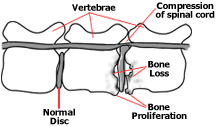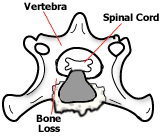|
A dog's spine is made up of numerous small bones called vertebrae. These extend from the base of the skull all the way to the end of the tail. The vertebrae are interconnected by flexible discs of cartilage - the intervertebral discs. These discs provide cushioning between each bone and permit the neck, spine, and tail to bend, allowing changes in position and posture. Above the discs and running through the bony vertebrae is the spinal cord, which is made up of a mass of nerve fibers that run back and forth between the brain and the rest of the body.
What is diskospondylitis?
 Diskospondylitis (also spelled 'discospondylitis') is a bacterial or fungal infection of the vertebrae and the intervertebral discs in dogs. The resulting swelling, inflammation and bone deformities seen in diskospondylitis put pressure or compression on the spinal cord which runs through the vertebrae. The disease is termed "spondylitis" when only the vertebrae are involved. The disease should not be confused with 'spondylosis,' which is a non-infectious fusion or degeneration of the vertebrae. Diskospondylitis (also spelled 'discospondylitis') is a bacterial or fungal infection of the vertebrae and the intervertebral discs in dogs. The resulting swelling, inflammation and bone deformities seen in diskospondylitis put pressure or compression on the spinal cord which runs through the vertebrae. The disease is termed "spondylitis" when only the vertebrae are involved. The disease should not be confused with 'spondylosis,' which is a non-infectious fusion or degeneration of the vertebrae.
What causes diskospondylitis?
 Diskospondylitis seems to occur most commonly in areas of the country that have a problem with plant awns (e.g., grass seeds, fox tails). It is thought that bacteria or fungi on the awns enter the blood system when the awns pierce the skin. Bacterial endocarditis, urinary tract infections, or dental
disease or extractions may be another means by which bacteria enter the bloodstream and infect the vertebrae. Brucella canis has also been found to cause the disease in dogs. Diskospondylitis seems to occur most commonly in areas of the country that have a problem with plant awns (e.g., grass seeds, fox tails). It is thought that bacteria or fungi on the awns enter the blood system when the awns pierce the skin. Bacterial endocarditis, urinary tract infections, or dental
disease or extractions may be another means by which bacteria enter the bloodstream and infect the vertebrae. Brucella canis has also been found to cause the disease in dogs.
What are the symptoms of diskospondylitis?
Common symptoms of this disease include weight loss, lack of appetite, depression, fever, and back pain. Dogs with this disease are generally reluctant to run or jump.
How is diskospondylitis diagnosed?
Diagnosis of diskospondylitis can be difficult. Blood tests, urinalysis, radiographs (x-rays), and spinal taps may be necessary to diagnose the disease. Cultures of blood and urine are often performed to help isolate the cause and choose the appropriate treatment. Myelography may be indicated to determine the exact location of spinal compression. Surgery may be needed to reduce the compression on the spinal cord.
How is diskospondylitis treated?
Treatment is based on finding the causative agent - fungal or bacterial. Because bone infections are difficult to treat, therapy lasts at least six weeks and may continue for six months or more. Taking radiographs at regular intervals during treatment helps monitor the progress. The lesions seen early in the disease should resolve with treatment.
Clinical improvement (lessening of symptoms) usually occurs within two weeks of starting treatment. Pain medication may be needed early in treatment. Exercise restriction may help decrease the pain also.
The prognosis depends on the ability to eliminate the infection and on how much nerve damage resulted from the spinal compression.
Veterinary & Aquatic Services Department, Drs. Foster & Smith, Inc.
Web Page |